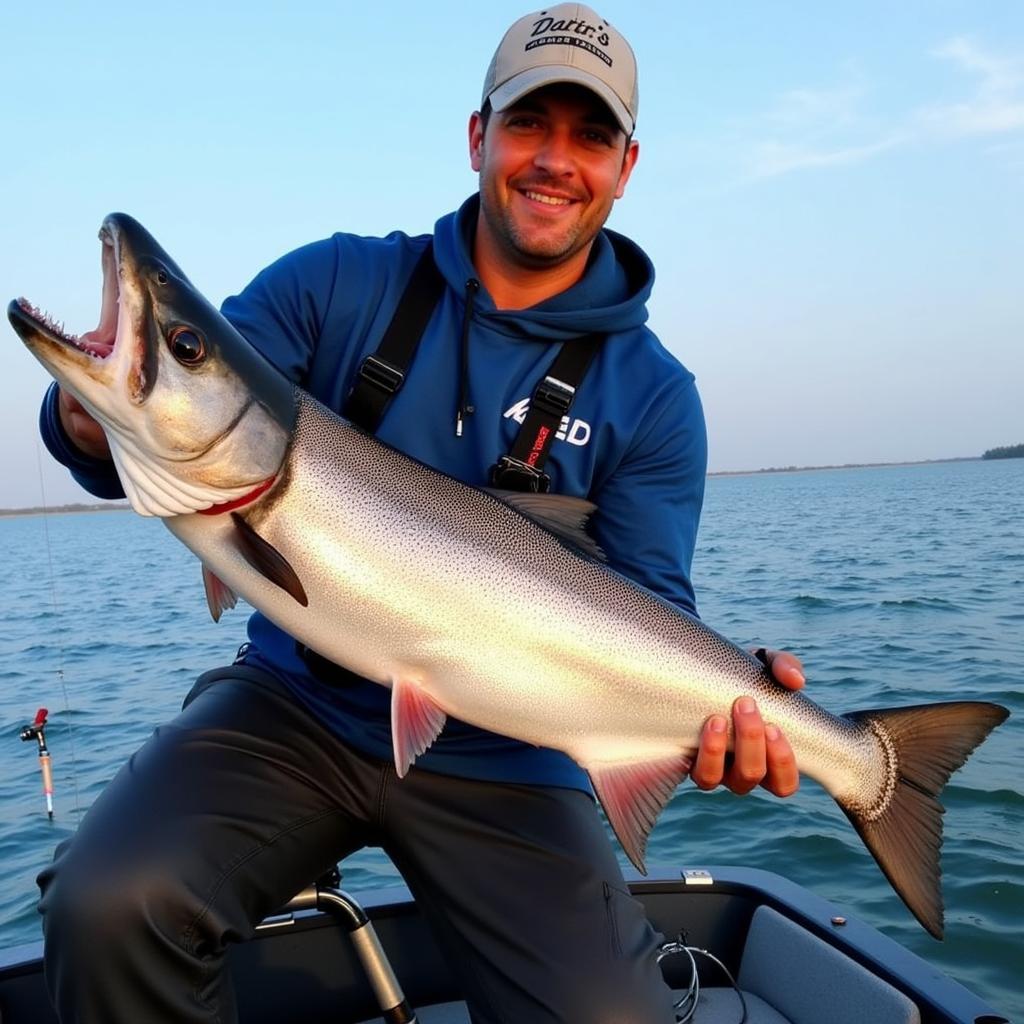Understanding the Chinook Diver Chart
December 7, 2024The Chinook Diver Chart is a crucial tool for anglers targeting chinook salmon. It helps predict the optimal diving depth for lures, increasing the chances of a successful catch. This article will delve into the intricacies of using a chinook diver chart effectively, empowering you to become a more proficient salmon fisherman.
Decoding the Chinook Diver Chart: A Comprehensive Guide
Chinook salmon, also known as king salmon, are prized for their size and fighting spirit. Catching these magnificent fish often involves trolling with downriggers and divers, and understanding how to use a chinook diver chart is essential for presenting your lure at the correct depth. These charts provide estimates of how deep your diver will run based on the amount of line you let out and the size of the diver being used.
Why is Diver Depth Crucial for Chinook Salmon?
Chinook salmon often hold at specific depths depending on water temperature, light penetration, and prey availability. Using a chinook diver chart allows you to target these preferred depths, significantly improving your chances of hooking a king. Without a chart, you’re essentially guessing the depth of your lure, which can lead to wasted time and frustration.
- Target Specific Depths: Accurately present your lure within the strike zone.
- Increase Catch Rates: Maximize your chances of hooking a chinook.
- Adapt to Changing Conditions: Adjust your fishing strategy based on water temperature and other factors.
Factors Affecting Diver Depth
Several factors influence how deep your diver will run, and understanding these variables is vital for interpreting the chinook diver chart accurately.
- Line Diameter: Thicker lines create more drag, reducing the diving depth.
- Trolling Speed: Faster speeds generally increase the diving depth.
- Current: Strong currents can influence diver depth and require adjustments.
- Diver Size and Type: Different diver designs have varying dive curves.
It’s crucial to consider these factors when consulting your chinook diver chart. Slight variations in these elements can impact the final depth of your lure. Experience and experimentation are key to fine-tuning your setup for optimal results.
Reading and Interpreting a Chinook Diver Chart
Chinook diver charts are typically presented as tables or graphs. They display the relationship between the amount of line released, the diver size, and the estimated diving depth.
- Line Out: This refers to the length of line you let out behind your boat.
- Diver Size: Charts often list different diver sizes, each with its own dive curve.
- Diving Depth: This is the estimated depth your diver will achieve.
Tips for Using a Chinook Diver Chart Effectively
While the chart provides a valuable starting point, practical experience and adjustments are essential.
- Start with the Chart’s Recommendations: Use the chart as a baseline and then adjust your line out based on your sonar readings and observed fish activity.
- Calibrate Your Setup: Test your diver’s actual depth with a line counter or depth finder to ensure accuracy.
- Observe Fish Behavior: Pay attention to where you’re getting bites and adjust your diver depth accordingly.
“Understanding how to read a chinook diver chart is like learning a new language,” says renowned fishing guide, Captain John Smith. “Once you master it, you’ll be able to communicate with the fish on their terms.”
Common Chinook Diver Chart Misconceptions
Many anglers make the mistake of assuming the chart provides absolute depth readings. It’s important to remember that these are estimates, and several factors can influence the actual diving depth.
- Not Accounting for Variables: Failing to consider factors like current and line diameter can lead to inaccurate depth estimations.
- Ignoring Sonar Readings: Relying solely on the chart and neglecting sonar feedback can result in missed opportunities.
“Don’t just blindly follow the chart,” advises expert angler, Sarah Jones. “Use it as a guide, but always verify your diver’s depth with your sonar and make adjustments based on the conditions.”
Conclusion
Mastering the chinook diver chart is a game-changer for any serious salmon angler. By understanding how to interpret the chart and adjusting your setup based on the prevailing conditions, you can significantly increase your chances of landing that trophy chinook. So, grab your chart, hit the water, and start exploring the depths!
 Chinook Diver Success
Chinook Diver Success
FAQ
- Where can I find chinook diver charts? Tackle shops, fishing websites, and diver manufacturers often provide these charts.
- Are all chinook diver charts the same? No, charts can vary slightly depending on the diver brand and design.
- What is the best size diver for chinook salmon? The optimal diver size depends on factors like trolling speed, target depth, and the size of your lure.
- Do I need a downrigger to use a diver? While downriggers enhance diver fishing, they are not strictly necessary.
- How often should I check my diver’s depth? Regularly check your diver’s depth, especially when changing trolling speed or encountering different current conditions.
- Can I use a chinook diver chart for other salmon species? Yes, but the optimal depths may vary depending on the target species.
- What other tools are helpful for chinook fishing? Fish finders, line counters, and temperature probes are valuable tools for successful chinook fishing.
For further assistance, please contact Phone Number: 0963418788, Email: [email protected] Or visit our address: 2M4H+PMH, Phường Nghĩa Thành, Gia Nghĩa, Đắk Nông, Việt Nam. We have a 24/7 customer support team.